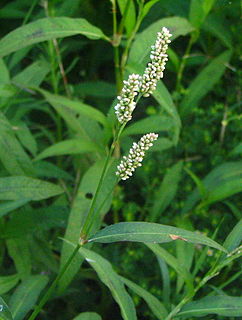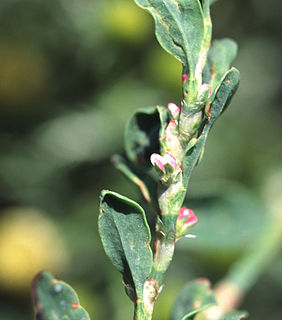
Polygonum arenastrum, commonly known as equal-leaved knotgrass, is a summer annual flowering plant in the knotweed family Polygonaceae. It is native to Europe and can be found on other continents as an introduced species and a common noxious weed. Other common names include common knotweed, prostrate knotweed, mat grass, oval-leaf knotweed, stone grass, wiregrass, and door weed, as well as many others, knotweed was first seen in North America in 1809 and is now seen across much of the United States and Canada.
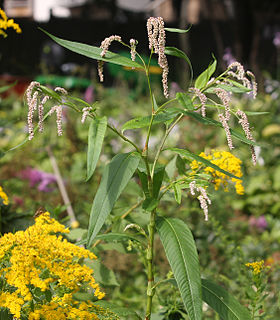
Persicaria lapathifolia, known as pale persicaria, is a plant of the family Polygonaceae. It is closely related to Persicaria maculosa and as such is considered a weed in Britain and Europe. Other common names for the plant include pale smartweed, curlytop knotweed, and willow weed. It is a species complex made up of a great many varying forms, sometimes considered varieties. The environment also has a strong influence on the morphology of an individual plant.
Polygonum ramosissimum is a North American species of herbaceous annual plants in the buckwheat family, widespread across much of Canada and the United States, where it is commonly called bushy knotweed.
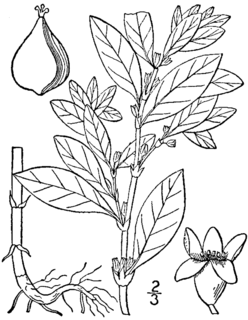
Polygonum erectum is a North American species of annual plant species in the buckwheat family, with upright or ascending stems, called erect knotweed. It was once cultivated for food by Native Americans as part of the group of crops known as the Eastern Agricultural Complex. It is found primarily in the northeastern and north-central parts of the United States, but with scattered populations in other parts of the US and also in Canada.
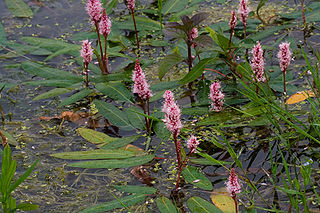
Persicaria amphibia is a species of flowering plant in the knotweed family known by several common names, including longroot smartweed, water knotweed, water smartweed, and amphibious bistort. It is native to much of North America, Asia, Europe, and parts of Africa, and it is known elsewhere as an introduced species and sometimes a noxious weed.
Polygonum bidwelliae is an uncommon species of flowering plant in the knotweed family known by the common name Bidwell's knotweed. The plant was named for American suffragist Annie Bidwell, who at one time lived in the Bidwell Mansion in Chico, California. She is the person who collected the type specimen in Northern California.
Polygonum bolanderi is an uncommon California species of flowering plant in the buckwheat family known by the common name Bolander's knotweed.
Polygonum californicum is a species of flowering plant in the buckwheat family known by the common name California knotweed. It is native to the west coast of the United States from Washington, Oregon, and northern and central California in the Coast Ranges and Sierra Nevada foothills as far south as Napa and Tulare Counties. It can be found in many types of open habitats.
Polygonum marinense is a rare North American species of flowering plants in the buckwheat family known by the common name Marin knotweed. It is endemic to California, where it is known from just a few locations north and east of San Francisco Bay.
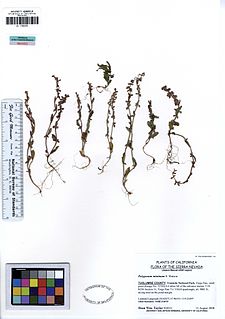
Polygonum minimum is a species of flowering plant in the knotweed family known by the common name broadleaf knotweed. It is native to much of western North America where it can be found in mountainous regions. It grows in the subalpine and alpine climates of high mountain ranges from Alaska to Arizona and New Mexico.
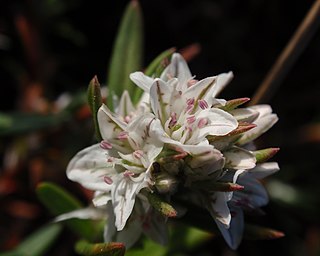
Polygonum paronychia is a species of flowering plant in the knotweed family known by the common names dune knotweed, black knotweed, and beach knotweed. It is native to the coastline of western North America from British Columbia to California, where it grows in sandy coastal habitat such as beaches, dunes, and scrub.
Polygonum parryi is a species of flowering plant in the knotweed family known by the common names Parry's knotweed and prickly knotweed. It is native to the western United States from Washington to California, where it grows in several types of moist, open habitat in mountainous and coastal areas.

Polygonum polygaloides is a North American species of flowering plants in the buckwheat family known by the common names milkwort knotweed and polygala knotweed. It is native to much of western North America, where it can be found in many types of moist habitat. It is a variable species, usually divided into a number of subspecies.

Persicaria punctata is a species of flowering plant in the knotweed family known by the common names dotted smartweed and dotted knotweed.
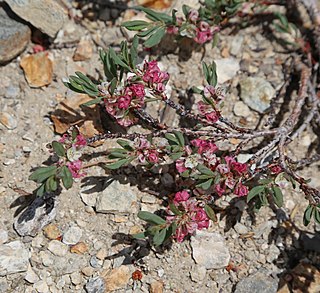
Polygonum shastense is a species of flowering plant in the knotweed family known by the common name Shasta knotweed. It is native to sections of southwestern Oregon, northwestern Nevada, and northern and central California, where it grows in rocky and gravelly mountainous habitat up to 3300 meters (11,000 feet) elevation. It is most common in the Sierra Nevada. The species name refers to its occurrence on Mount Shasta in Shasta County, California.
Polygonum austiniae, common name Mrs. Austin's knotweed, is a plant species in the buckwheat family. It is native to western Canada and the western United States, from Alberta and British Columbia south as far as California, Nevada, and Wyoming.
Polygonum cascadense is a species of flowering plant in the buckwheat family known by the common name Cascade knotweed. It has been found only in the State of Oregon in the northwestern United States, in the Cascades and in the Blue Mountains.
Polygonum engelmannii, common name Engelmann's knotweed, is a North American species of plants in the buckwheat family. It is native to western Canada and the western United States, usually at high elevations in the mountains. It has been found in Alberta, British Columbia, Idaho, Montana, Wyoming, Nevada, Utah, and Colorado.
Polygonum majus is a North American species of flowering plant in the buckwheat family known by the common name wiry knotweed. It grows in the western United States and western Canada, from British Columbia south as far as the Sierra Nevada of northwestern Inyo County in California, east as far as Montana.

Polygonum oxyspermum is a coastal species of flowering plant in the buckwheat family. It is native to Europe, primarily along the shores of the Atlantic, the North Sea, and the Baltic Sea, from France and Ireland to Finland and Russia. It is also naturalized in eastern Canada and in the US State of Maine.

